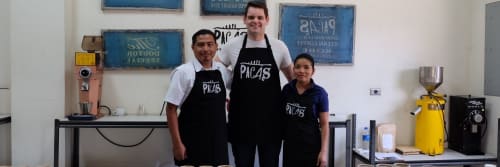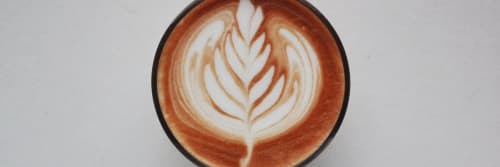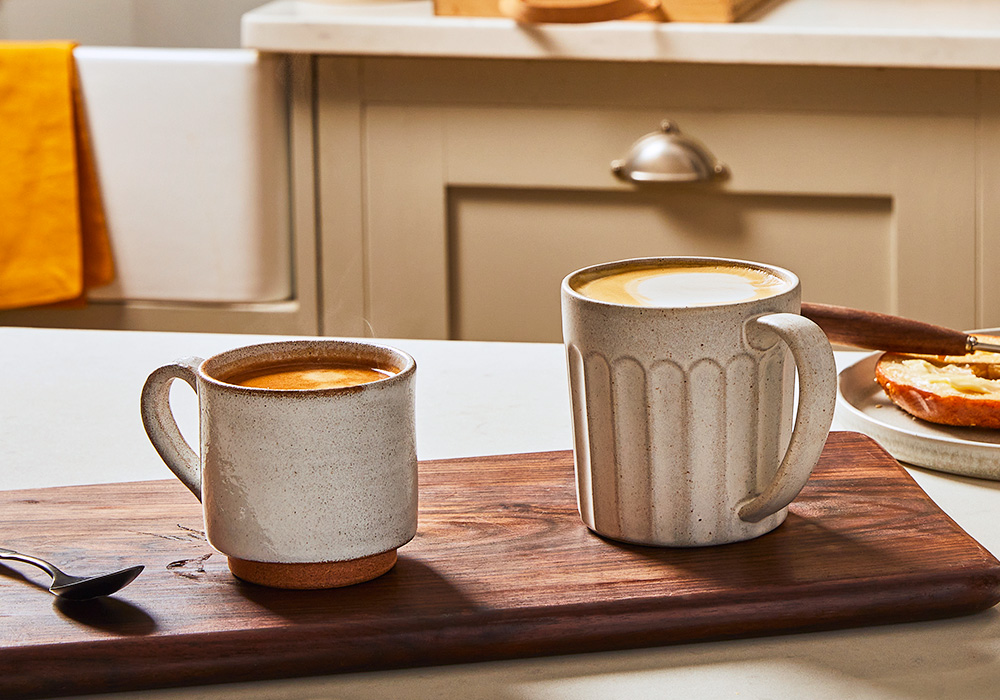From the outside looking in, the world of coffee can seem intimidating. There is so much coffee lingo to get to grips with - it can feel like learning a new language! To make life easier, we’ve put together an ultimate coffee guide.
May you never be bamboozled by coffee jargon again.

Acidity
You will see this term used across our coffee cards and product pages, but what does acidity really mean? It’s the sensation you get on your tongue when you sip the coffee. Coffee can be low or high acidity and this affects the overall taste. If coffee has high levels of acidity it is generally referred to as ‘bright’ whereas a lack of acidity altogether would be described in a ‘flat’ or ‘dull’ cup. There are 5 major terms we use to describe the acidity in coffee including malic (a similar sensation to juicy apples), citric (think lemons and oranges) and tartaric (a grape-like undertone.)
Arabica Coffee
Coffee beans come from either the Arabica or Robusta plant species. Arabica makes up the majority of the world’s coffee production - around 75%. Arabica coffee is more difficult to grow than Robusta, but the results are better and Arabica benefits from more complex tastes and flavours. At Pact, we only use 100% high-quality Arabica coffee beans in our products.
AeroPress
Invented in 2005 by record-breaking Aerobie Frisbee maker Alan Adler, the AeroPress is an affordable brewing kit. It is a speedy brewing device (we’re talking cupboard to cup in 2 minutes), portable and highly rated among seasoned coffee lovers.
Read more: How to make AeroPress Coffee

Balance
When we talk about a coffee’s balance we refer to all the tastes interacting together on your tongue including the acidity, bitterness and saltiness. Of course, we hope you won’t be tasting saltiness in a Pact Coffee but you’d be surprised by all the delicious coffees out there which feature intense bright acidity or savoury tastes. Coffee may be complex in its depth but if it is balanced correctly there should be no one overriding characteristic.

Barista
The term ‘barista’ originated in Italy and translates to ‘bartender.’ Nowadays, it is a globally recognised definition for anyone who can brew espresso drinks professionally and make a range of coffees including cappuccinos and lattes. A barista will be competent in a range of brew techniques and will be able to perfect latte art hearts which leave amateurs in a flap. Coffee machines are often described as ‘barista’ which is a clever marketing term to indicate you can achieve café-quality coffee at home.
Caffeine
Caffeine is a naturally occurring stimulant found in coffee which leads to more activeness in the brain and body. The amount of caffeine found in coffee products varies depending on origin, the specific coffee plant (Arabica or Robusta) and the altitude it is grown at. And, when it comes to your morning brew the caffeine content will also vary depending on the amount of ground coffee used to make the brew and the ratio of water to coffee.

Cafetière
Also known as a French Press, this is essentially a coffee plunger. Ground coffee is steeped into a cafetière and hot water is poured on top. After stirring, coffee is left to brew for 4 minutes. Next, the drinker presses down on the metal filter which pushes the sediment to the bottom, leaving deliciously brewed coffee ready for pouring.
Read more: How to make cafetière coffee
Chemex
This coffee maker looks like something you might find in a Year 9 Chemistry class. Invented in 1941, the Chemex has achieved cult status for its stylish look and brewing capabilities. It’s a manual pour-over brewer using medium ground coffee and, crucially, thick paper filters which have a big impact on the resulting drink.
Coffee Cherries
Did you know that coffee beans begin life as cherries which grow on trees in tropical countries such as Colombia, Rwanda and Brazil? Inside the juicy cherries, there are two seeds. These seeds are released from inside the cherry using either a washed, pulped or natural process. Each process has a different impact on how the coffee tastes. After processing, these seeds eventually become the coffee beans we roast, grind and ship to your door!

Cold Brew
It’s the coffee you know and love, just colder. Instead of using a kettle or coffee machine, you’ll need a jug, a fridge and cold water to perfect this summer brew.
Read more: How to make cold brew coffee
Coffee Cupping
Coffee cupping is a process that our Head of Coffee, Will, is very familiar with. It’s a globally recognised coffee-tasting technique used to check the quality of a particular coffee batch. During the cupping process, Will scores each coffee based on characteristics such as acidity, balance, flavour, mouthfeel and sweetness. Each characteristic is scored out of 10 and the total is added up. This is a crucial process and only the very best quality coffee makes it to your lips.
Read more: What does a Head of Coffee do?
Decaf Coffee
To remove some or all of the caffeine in coffee, it must go through a decaffeination process. This always occurs when the coffee is green (pre-roast). Two common processes used for speciality coffee are the Swiss Water Technique and the C02 method.
Read more: How is decaf coffee made?
Dose
A dose is the amount of ground coffee (best measured in weight) that you use to prepare your brew. Weighing coffee might seem like overkill to the untrained coffee sipper, but the truth is that by measuring your coffee, you can be sure of a consistently great brew every single time.
Drip Coffee
When hot water is passed through a cone holding filter paper and ground coffee, the coffee can be referred to as ‘drip.’ This term is most commonly used in relation to electric coffee makers and the Pact V60.

Espresso
Since its creation in 1884, the espresso has delighted caffeine lovers. It is a strong coffee shot brewed under 9 bar pressure. Espresso coffee is highly concentrated - the ratio of water to coffee is much less when brewing an espresso compared with larger brews such as drip coffee. Although espressos in their purest form are served without milk, coffees such as cappuccinos and lattes start with a shot of espresso before adding milk in different ratios.
Read more: How to make Espresso
Flat White
Despite being around since the 80s, the flattie has shot to fame in the last 5 years. When prepared properly, the flat white is a strong, luxurious coffee made with a double ristretto and warm steamed milk.

Flavour
Flavour aromas come from the nose and tongue. Although there are hundreds of possible flavour attributes in coffee, there are 9 key flavours on the SCA Coffee Flavour Taster Wheel, including floral, fruity and cocoa. At Pact, we believe that variety is the spice of life and offer an ever-changing menu of globe-spanning coffees boasting flavours such as apple pie, sweet sherbet and dark chocolate.
Green Coffee
Green coffee has been harvested and processed, but it has not been roasted. When coffee is first delivered to our Surrey roastery, it looks and smells like dried peas.
Grind
Do you prefer your coffee to be wholebean, medium, medium-fine or coarse? Your grind preference will depend on the way you brew your coffee. If you’re a V60 lover, you’ll want to choose a medium grind, whereas if you use an espresso machine a fine grind is best. Supermarkets tend to take a one-size-fits-all approach to ground coffee, which is bad news for your brew as you end up with lots of different sized particles and the coffee often extracts poorly. When you buy from Pact, we make sure you get the perfect particles for your intended brew method every single time.
Read more: How to grind coffee
Honey Process
No, this doesn’t actually involve any honey. It’s called the honey process because the golden, sticky layer of mucilage that surrounds the coffee seed looks a little like honey and the resulting taste is often sweet. The honey process involves coffee cherries being picked at their best ripeness and sorted in a flotation tank. The cherries that float are culled from the batch and the remaining ones have their skin removed before being dried for 2-3 weeks.
Instant Coffee
A sad face emoji in a cup… Jokes aside, instant coffee is generally poor-quality coffee in the form of granules or powder which has been freeze dried or spray dried. It often contains harmful chemicals, too. We might be a tad biased, but we believe that once you try speciality coffee, you never go back.
Latte (Caffe Latte)
In a recent poll of our customer’s coffee preferences, the flat white majorly trumped the latte, suggesting that this drink has had its heyday. Originally made with drip coffee and warm milk, the latte as we know it today is an espresso with steamed milk on top and has been around since the dawn of American coffee chains like Starbucks. It is often served in a long glass cup.

Micro-Lot
The industry term ‘micro-lot’ relates to the fact that micro-lots are produced in limited, small lots or batches from a specific region and variety. Only extremely high-scoring coffees make the cut when it comes to our micro-lots. Pact micro-lot coffee scores at least 86/100 on the speciality grading scale and to put this into perspective they are in the top 0.1% of global coffee.
Mouthfeel
We score coffee mouthfeel (or body) for quality when we conduct our cupping process. How does the coffee feel in the taster’s mouth? Heavy and dense, or light and bright? Our coffees are often described as silky, or syrupy - describing the sensation of the coffee as you drink it.
Natural Coffee
The natural coffee process is easy to understand and execute but it’s hard to achieve amazing results. It’s the old-fashioned way of removing the green bean from the cherry. Coffee cherries are laid out on a drying patio immediately after picking. Then over the course of a month they are allowed to dry to a humidity at which the coffee can be stored without the worry of fermentation or mould impacting the end flavour. Once the coffee is dried the cherry is pulled off the outside of the two beans.

Origin
This refers to the country that the coffee is grown and processed in. The temperature and environment that the coffee is grown in has a distinct impact on the taste and quality of the coffee. At Pact, we source coffee from 8+ countries including Kenya, Rwanda, Brazil, Ethiopia, Colombia and El Salvador. A coffee referred to as single origin in the industry often means a coffee from several farms in the same country. At Pact, single origin means that our coffee comes from within a single farm or estate in a region.
Read more: What is single origin coffee?
Peaberry
These magic coffee beans are something of a rarity in the coffee world. Most coffee cherries contain two beans, but peaberries mutate in a rare, natural way which means that a single bean forms instead. The result is an even roast and a crystal clear taste.
Processing
Coffee cherries grow on trees, but the seeds inside the cherries have a long way to go before they end up as the beans we ship to you for your morning brew. There are a number of possible coffee processes including washed, natural and honey. Each process has a different impact on the resulting coffee bean.

Quality
Coffee is scored out of 100 points. To be considered speciality grade, the coffee must score a total of 80 points or above. Pact Coffee scores between 82 - 90+ points. Quality coffee should also be perfectly processed, perfectly roasted and perfectly brewed. If one or more of these factors is compromised, the coffee you sip will be far from dreamy.
Read more: Speciality coffee scores explained
Roast
Once coffee is grown and processed, green coffee beans arrive at our Surrey roastery ready to be transformed. This is literally where the (coffee) magic happens. The roasting process is what brings out the distinctive flavour of coffee and taste. It’s a tricky balancing act as over-roasting coffee could ruin the beans. Think of it like toasting bread- although most people have different toasting preferences, very few of us enjoy it burnt to a crisp which is how the majority of coffee is roasted in the UK.
Read more: The difference between a dark and light roast
Robusta Coffee
Robusta coffee plants contain double the caffeine content of Arabica, they are also easier and faster to grow. To those who love a coffee ‘buzz’ this might sound great, but Robusta is seen as the inferior bean in the world of speciality coffee as it doesn’t benefit from complex tastes and flavours. Robusta produces a high bitterness which usually ends up as instant coffee. It is also mechanically harvested, further decreasing the coffee quality. At Pact we only use 100% Arabica beans in our coffee.

Speciality
What separates speciality coffee from your standard supermarket fare? Speciality coffee must score highly by the SCA (Speciality Coffee Association)- at least 80/100 and it must not have any taste or flavour defects.
Sweetness
It’s important to note that there’s no actual sugar in coffee. The flavour, mouthfeel and acidity combine to create the illusion of sweetness and that’s what we are describing when we talk about sweetness in coffee. Of course, there are different kinds of sweetness. A bag of chocolate buttons is sweet, but so is a punnet of strawberries. Sherbet, caramel, baked fruit - it’s about identifying the sort of sweetness there is in your cup of coffee.
Variety
A variety of coffee is a sub-species of the Arabica plant. Each variety has specific traits to do with cup quality, production yield and disease resistance. At Pact, we want to encourage farmers to plant varieties that are going to give them longevity, disease resistance and good cup quality but often within the industry farmers will be encouraged to plant varieties that are not beneficial long-term. We never ask farmers to plant varieties that are against their best interests or not viable long-term.

V60
If you are a Pact customer then it’s highly likely you’ve had an exciting brown box containing a Hario V60 delivered to your door. It’s a great way to brew coffee because it’s speedy and easy-to-clean. Why is it called a V60? We hear you ask. The reason is all to do with the paper filters. When they are closed, they are at a 90 degree angle, but when they are open they become a cone at a 60 degree angle. The V is the sign for an angle.
Read more: How to make V60 coffee
Washed Process
This process produces the best clarity of flavour. Coffee cherries are put into a de-pulper, the skin is taken off the outside along with most of the pulp and the beans are left to ferment for 12-36 hours which has a major impact on the taste and flavour of the final coffee. After the fermentation the coffee is washed using fresh water before being put out to dry on raised beds or patios for 1 - 2 weeks.
You made it to the end? Phew! Thanks for reading. Time to reward yourself with a brew.







